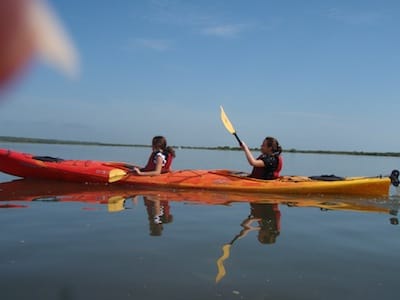When you drive through Florida, the tall grass and low trees and shrubs that grow in the the marshes and along the Intracoastal waterway are beautiful scenery, and a great place for a meal at a marsh-side restaurant or a picnic at a public park.
But what must it have been like hundreds of years ago, when Indians paddled canoes through the waterways to get from one place to another, to fish for their meals and to gather food; when the Spaniards used the water to protect their settlements; and when the early settlers came to Florida and used the waterways to get around? And I had to wonder, how did they manage it in the summer heat?
Kayaking the Mangrove Marsh
Finally, my curiosity was settled: we scheduled a tour with Ripple Effect Kayaking Eco Tours in Marineland during our vacation to St. Augustine, Florida ($55 for adults, $45 for children for a two hour tour). And being August, I was sure I’d get the real experience–it was sure to be hot.
Our tour started off at 9 AM; being August, we were advised against the afternoon tour since thunderstorms are frequent (and indeed, we had thunderstorms many of the days we were there). Also, the morning tours are quite comfortable, with temperatures in the 70‘s.
As our tour took us up the creek and past Princess Place, past the grassy shores and mangrove shrubs, Danny explained that the marshes are where sea life begins: Ninety percent of fish that ends up in fish markets and on our tables starts in estuaries like the one we toured, so that’s why it’s so important to protect these waters. That Pellicer Creek was designated a federal preservation area in 1970 was great foresight: Just to the south, Flagler County became the highest growth area in the country during the real estate boom. Without the protection of the area, the building, agricultural runoff and pollution certainly could have damaged the estuaries where fish, birds and other animals nest and breed. But the government’s efforts worked: the Pellicer Creek’s waters are pristine. Were the water not mixed with salty ocean water, it would be fine for drinking.
As our boats turned north, the incoming tide made paddling a bit harder (but also better exercise!). We paddled against the tide and eventually emerged from the marsh at a bridge just north of Marineland. Once we turned south again, the ride became quite easy–the tide did most of the work. Quickly we were back on shore at the Marineland Marina where we started. Our two-hour tour was sadly over, but I felt exhilarated: I’d exercised, learned a lot, and done something new. And, even though it was 11 AM and the day was heating up, I wasn’t sweating. I was sad the tour was over, but it whet my appetite for more: Ripple Effects has four locations and a variety of tours, including one that visits the Princess Place Preserve, which is on my list for next time!

